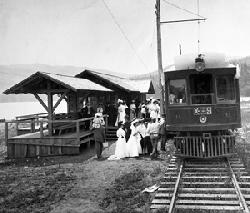|
||||
|
History: Region’s railroad heritage influenced LL development
3/27/2013 12:07:48 PM
By Karolyn Kosanke
Liberty Lake Historical Society
In the mid-1800s, the railroad industry began developing routes into the Pacific Northwest. As the railroad progressed, settlers moved into the area and led the way to economic development in the Spokane area. Interurban electric trains were developed, not only as people movers but for the transport of commercial goods.
President Abraham Lincoln signed The Railroad Act of 1862. This authorized land grants in the western United States and the issuance of 30-year government bonds to the Union Pacific, Central Pacific and Southern Pacific railroads to aid in the construction of a railroad and telegraph line from the Missouri River to the Pacific Ocean. Government aid took the form of land grants and subsidies. The road was to have a 400-foot right-of-way through the public domain, plus 10 sections of land for every mile of track.
Railroad expansion provided new avenues of migration. Due to the growing population, the railroads sold portions of their land to arriving settlers at a handsome profit. Land closest to the tracks drew the highest prices as farmers and ranchers wanted to locate near railway stations.
In 1881, the Northern Pacific Railroad arrived in Spokane. The company goal was to connect the Great Lakes to the Puget Sound. This was one of many railroads that would support economic growth in mining, lumber, agriculture and population. As with many towns in the United States, it was the railroads that turned Spokane Falls (later changed to Spokane) into the center of the Inland Empire.
In 1890, Francis H. Cook owned the Spokane and Montrose Street Railway, which was Spokane's first electric train. In 1902, he sold it to Jay Graves. Graves and his partners reorganized the Spokane and Montrose as the Spokane Traction Company in 1903.
| DID YOU KNOW? • Architect Kirtland Cutter designed the depots at Hayden and Liberty Lake. The resort depots were large covered platforms, 50 feet long, to accommodate large crowds. • Along the electric line from Spokane to Coeur d'Alene were sub-stations that housed batteries to support the train. The Coeur d'Alene sub-station is now the Human Rights Education building next to the North Idaho Museum. • A frequency changing station that converted 4,000 volts/60 cycle to 2,200 volts/25 cycle is located on the south side of Interstate 90 near the Hamilton Street exit. • One of the largest known crowds at the lake gathered here for the Fourth of July celebration of 1924. Of the estimated 14,000 who attended the festivities that summer day, 9,000 arrived by train. The Development of a Community A series from the Liberty Lake Historical Society, appearing in the first Splash issue of each month in 2013. January: Relocation of the Coeur d'Alenes February: Formation of the Coeur d'Alene Indian Reservation March: Transportation Overview April: Railroads May: Homesteaders June: Homesteaders in the hills July: Utilities August: Church September: School October: Commerce November: Government December: Medical |
Emmett Denison, who lived near the Liberty Lake station, met the trains with his horse-drawn stage and transported visitors to the lake for 25 cents.
Later, the Coeur d'Alene and Spokane won a Railway Mail Service contract for the railway post office service between Spokane and Coeur d'Alene. In June 1907, service began with two round trips daily. Electric passenger trains also hauled a baggage and mail car. Eventually, mail cranes were installed at Millwood and Spokane Bridge for non-stop mail exchange.
As Liberty Lake developed, the Coeur d'Alene and Spokane Railway agreed to build a spur line from the original Liberty Lake station on the main line and run along a two-mile stretch to the lake. Railroad officials originally turned the idea down, but as Liberty Lake became more popular to Spokane residents and the number of passengers using the Liberty Lake station grew, they agreed.
In March 1907, the Liberty Lake station was renamed Liberty Lake Junction. The spur line was laid from Liberty Lake Junction to Liberty Lake Park (present-day Alpine Shores), making a loop back to the Junction.
June 15, 1907, was opening day of the summer schedule on the Coeur d'Alene division. Three trains now ran from Spokane to Liberty Lake Junction, where passengers could now change trains and go on to Liberty Lake Park.
The Spokane Inland Empire Railroad further developed Liberty Lake Park, which was completed in 1909. Popular for picnics and gathering, the park drew a large summer crowd.
The Liberty Lake Improvement Company, a division of the Railroad headed up by Jay Graves and other Spokane businessmen, developed the park/resort for the branch line. The area "Wicomico" (the sandy strip on the west side of the lake) was promoted to support land sales. The Spokane and Inland Empire report by President Jay P. Graves informed stockholders in 1909 that the railway had developed a "first class summer resort" at Liberty Lake with the finest bathing beaches in the country, a 35-acre park, a $10,000 pavillion, bathhouses and a 500-foot pier.
Daily trains increased from 1910-1913, running every half hour on Sundays and holidays. Cars normally carried up to 60 passengers, but could carry double that number standing in the aisle and on the platforms. Open cars hauled even more passengers hanging onto the outside of the car.
From 1910 to 1915, Liberty Lake Park became known as "Spokane's Inland Seashore." The All Valley Picnics and other business picnics were hosted at the park, where guests could fish, rent swimsuits, relax and enjoy the water. The dance pavillion as well as the resorts and hotels brought entertainment to the lake.
The 1920s brought major changes to Liberty Lake. As roads for automobiles were built, passenger train travel began to decrease.
The electric railways of the Inland Empire merged in 1922, forming Spokane United Railways. This company slowly converged to bus service, ending electric rail operations into the lake in 1927 and ceasing the remainder by 1936. With the Burlington Northern Railroad merger of 1970, the old interurban system became unprofitable, and the Spokane and Inland Empire system became entirely abandoned between 1970 and 1985.
Karolyn Kosanke is a board member of the Liberty Lake Historical Society. She remembers her parents talking about riding the train from Greenacres to Liberty Lake Park to enjoy the dances, music and All Valley Picnics. "They loved the lake so much, they moved here in 1943, and I'm glad they did," Kosanke says. Kosanke loves the lake, too: After growing up here, she moved back "home" with husband, Richard, in 2008.



